![]()
2017
This page presents reviews of the performances that took place in 2017. We would like to express our gratitude to the authors for their invaluable contributions.
Copyright notice: The reviews published on this page are the intellectual property of the respective contributors and are subject to UK and International Copyright Laws. Their use/reproduction without the authors’ explicit permission is illegal.
By Anja-Rosa Thöming
Oper Frankfurt, first night 19. 2. 2017; conductor: John Nelson, stage director Eva-Maria Höckmayr; selection of photos
Under the musical direction of the American conductor John Nelson the opera house of Frankfurt am Main presents a musically fine production of Berlioz’s War-and-love-opera Les Troyens. Nelson is the right person at the right place: a real Berlioz enthusiast he navigates with great confidence as well as musical expertise through the (unabridged) score. The musicians in the pit match such confidence; the balance of sound is excellent. Berlioz’ highly individual ‘Klangrede’ (meaning the eloquence of sound, after a famous term of the great Early-music conductor Nicolaus Harnoncourt) takes place not within a huge orchestra with overwhelming effects but within fine structured, clearly articulated phrases.
This musical eloquence speaks with fresh persuasion to us: there are dark, threatening, almost gripping moments, and there are moments of great sensitivity. What a thrilling sensation that the tragic history becomes real in the music!
What’s more, the connection between orchestra and singers is considerable. The Frankfurt opera company has in its own cast two female singers who represent powerfully the two centres of the work, Cassandre and Didon. Tanja Ariane Baumgartner and Claudia Mahnke are dramatic mezzo-sopranos alike and their vocal gifts appear as sovereign as is their stage presence.
The Deutsche Oper Berlin and the Hamburg State Opera have worked in their respective productions of Les Troyens (2015 and 2010) with international guests, almost as though it might be not really possible to sing for example the role of Cassandre when not highly specialised. But as Tanja Baumgartner demonstrates it is perfectly possible. Her stage French sounds true and comprehensible. Her singing of the awfully demanding part of Cassandre is always sovereign both in the more dramatic passages and in the lighter, more lyric moments.
Such a lyric moment is for example the sublime expression of sorrow for her lost love Chorèbe in her aria “Malheureux roi!” (“… plus d’hymen pour moi, / Plus d’amour, de chants d’allégresse…”). Perhaps to illustrate this moment, stage director Eva-Maria Höckmayr asks the singer to lie down and caress her own arms and body — a completely unnecessary gesture. Unnecessary because the expression is already fully developed in the score, in the poetic verse, in the singing imagination of the actress.
To make myself clear: lying down while singing is no technical problem for this outstanding mezzo-soprano but it is a problem of unwanted diversion symptomatic for the stage concept in general. The production tends to divert the attention of the public through far too many actions. Not only through minor actions like kneeling and rising up again but also through additional mute figures like Apollon and Hermes plus a dancing couple reflecting internal conflicts of Queen Didon. As if there were not enough people on stage to cope with!
The unfortunate result is that the eye sends many unclear messages to one’s mind in contrast to the ear that receives beautifully clear impulses from the music.
Another stage aspect that needs a critical word, because it matters, is the childlike appearance of the Trojan male heroes in short trousers. King Priam, Enée, Chorèbe and even the most serious ghost of Hector — they all wear boys’ short trousers together with jacket and tie. It looks ridiculous and you keep thinking “What do those shorts want to tell me? Have these men become childish?” It’s frustrating that those questions lead to no end, but they turn away the attention from the essence of an important scene or from a particular relationship between figures.
There are great moments — the final scene of Didon is really grand and fine opera thanks to the most intense impact of the accomplished singer Claudia Mahnke. But compared to the intelligent staging at the Staatstheater Karlsruhe (2011) or the beautiful, convincing minimalism of Herbert Wernicke’s 2000 Salzburg production, even to the suggestive bloodshed in the abridged Hamburg version (Thalheimer / Nagano), this new Frankfurt production is scenically as disappointing as the musical output is remarkable.
Anja-Rosa Thöming
Tanja Ariane Baumgartner (Cassandre) and Gordon Bintner (Chorèbe)

© copyright: Barbara Aumüller, Frankfurt am Main
Tanja Ariane Baumgartner (Cassandre

© Barbara Aumüller, Frankfurt am Main
Claudia Mahnke (Didon)
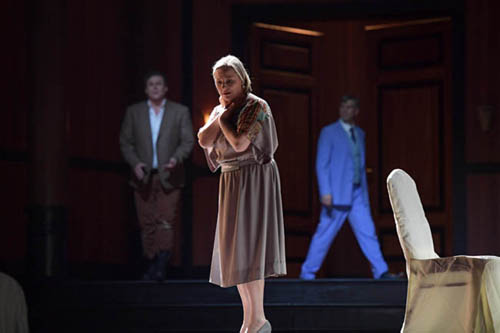
© copyright: Barbara Aumüller, Frankfurt am Main
Claudia Mahnke (Didon)
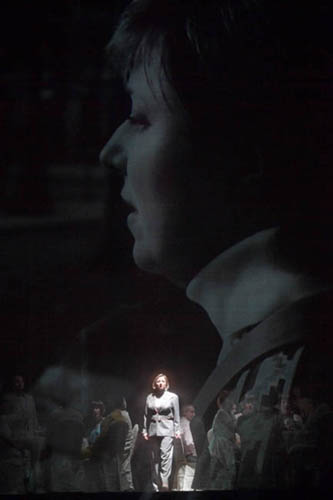
© copyright: Barbara Aumüller, Frankfurt am Main
By Anja-Rosa Thöming
Theater Bremen, 18. 3. 2017; conductor: Markus Poschner, director: Paul-Georg Dittrich, Jana Findeklee (video); selection of photos
“Il pleut du sang!” - it’s raining blood! -, sings Faust in La Damnation de Faust while galloping next to Méphistophélès towards the abyss of hell. In the new production of Berlioz’s Legende Dramatique at the Theater Bremen the blood is black; children dressed as little witches come with buckets and pour the liquid thoroughly onto the floor. With what looks like gigantic wands they spread the black blood carefully in all directions and in the end erect a huge canvas showing an elaborate black abstract painting. The little witches are proud as Méphistophélès himself (“Il est à nous! Je suis vainqueur!”) of their successful efforts in drawing Faust into eternal horror. Yet in this production the quiet, menacing painting marks a change in style; finally the moving pictures that caught the eye from the beginning have come to an end.
Conductor Markus Poschner knew what he did when choosing La Damnation as his farewell opera production (from September 2017 on he’ll be in charge of the music productions at the Austrian theatre of Linz and conduct La Damnation de Faust in a different setting in February 2018): The score is a festival of musically appealing contrasts woven into the well-known and intriguing legend of yearning Faust, loving Marguerite and sneering Méphistophélès. Berlioz’s work is a play not bound to a more or less logical stage plot but almost totally open to a dreamlike state, hallucinations, projections and thus to all sorts of pictures.
To combine a performance of Berlioz’s La Damnation with film sequences is therefore rather to be expected. Video artist Jana Findeklee surprises with technically brilliant and aesthetically suggestive moving pictures. At the beginning we look for about twenty minutes into white clouds floating in a blue sky. From time to time words in white are floating in the same sky: “Bin ich ein Gott - mir wird so licht”, later “Ihr alle fühlt geheimes Wirken der ewig waltenden Natur” (Goethe, we assume). It seems all very harmonious. The music is beautiful - it does not disturb one’s senses.
Slightly disturbing later on are the figures on stage. A male figure in a white frock, for instance, seems restless and unhappy. Who he is and what he wants we never get to know, only that he is called “Docteur” by another male figure in an identical white frock. This one seems to be in good health and at his ease.
A large group of people in white robes crowds onto the stage, smiling clinically. They have some mechanical contact with the unhappy white male figure but don’t recognize him as an individual nor does he recognize them as people. Who they are, whether real or semi-real or unreal, is a question that finds no answer. But questions of this type are of no further importance since all these figures are real in singing. The singing of the chorus is brilliant throughout the whole performance, powerful and at times sophisticated. The choirmaster, Italian Alice Meregaglia, has done a really good job. And again, conductor Markus Poschner knew what he did when choosing a piece that is dominated by dramatic chorus parts.
Enter Marguerite. The girl appears to be a projection even before she meets Faust - she has no personality but pretends to be a certain type of woman. Is she a projection of herself? Of “men”? Of “society”? Or simply of the production team? The chanson gothique “Le roi de Thulé” has her slapstick moment as a duet with a television. I liked the presentation of the last verse when the conductor appeared on the monitor in real time; it was very close to a concert performance (the solo viola player was great).
But slapstick is not enough for this scene full of double meanings; the song needs legato phrases, not only musically but intellectually as well, it requires a certain verbal intelligence like a Lied of Schubert. The duo of Faust and Marguerite was perhaps not as intense as it could have been because the singers did not address the beloved person directly but turn towards large fixed images of the other. This is, of course, a logical (but surely not the only possible) consequence of Berlioz’s own imagination of Faust’s fruitless attempts to live and to love.
The achievements of the singers are remarkable, although of the three leading roles only Canadian tenor Chris Lysack belongs to the ensemble of the theatre Bremen. His timbre is warm, his vocal presence quite strong and surely would have been even stronger if he didn’t have to act like an impersonal - white - being. The dashing performance of baritone Claudio Otelli as Méphistophélès shows no sign of weakness except perhaps for some verismo effects at the end of phrases which in my opinion don’t fit into the style of the music. Mezzo-soprano Theresa Kronthaler copes remarkably with the demanding part of Marguerite. Still, one remains rather untouched in hearing and viewing her sing the passionate role. This is not only due to the problematical decisions of the director regarding the identity of the girl. Moreover, the sound-shape (in German: Tongebung) of her voice seldom changes; even at the peaks of the arias, the forte sound remains uni-dimensional.
Fortunately the orchestra appears to be one of the more real characters in this performance of irrealities. Like the choir it guarantees a musically successful evening, setting standards.
Das Rheingold, Staatstheater Oldenburg, 19. 3. 2017. conductor: Hendrik Vestmann, director: Paul Esterhazy
A day later at the Staatstheater of Oldenburg (a charming, cosy, old-fashioned theatre known for musically valuable productions): Das Rheingold of Richard Wagner, an amazing performance! Quite intense, 2 hours and 20 minutes without a break. The public could hear, see and sense an intelligent interlock of music and stage which was really refreshing.
It goes without saying that you need a good portion of humour to bear Wagner’s obsession with alliterations. Director Paul Esterhazy gives a good portion of irony on top; Wotan especially is shown with several human weaknesses. But at the same time the director (who will unfold the tetralogy of the Ring over a period of the next three years) shows such a warm interest in all the figures that this ironic look is not destructive. And the singers apparently identify easily with the detailed concept - with full human and vocal power - and Johannes Schwärsky as the Nibelung Alberich is an example for all of his collegues. Estonian conductor Hendrik Vestmann made the orchestra sing, think, feel and reveal deeper layers completing the happenings on stage.
Anja-Rosa Thöming
Claudio Otelli (Méphistophélès) and chorus
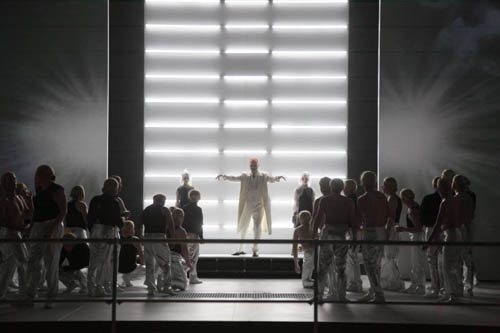
© copyright: Jörg Landsberg
Chris Lysack (Faust) and Claudio Otelli (Méphistophélès)
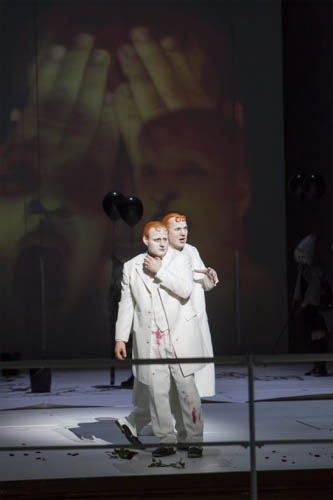
© copyright: Jörg Landsberg
Theresa Kronthaler (Marguerite) and children’s choir
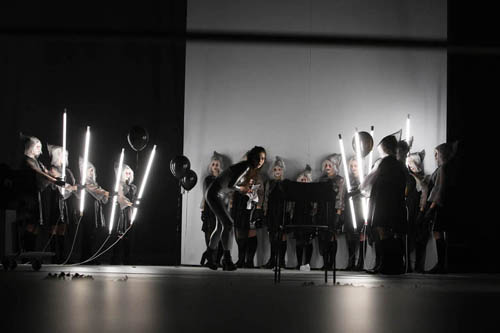
© copyright: Jörg Landsberg
Theresa Kronthaler (Marguerite)

© copyright: Jörg Landsberg
The Hector Berlioz Website was created by Monir Tayeb and Michel Austin on 18 July 1997; Reviews of live performances page created in 1999; completely reorganised on 25 December 2008.
© Monir Tayeb and Michel Austin. All rights of reproduction reserved.